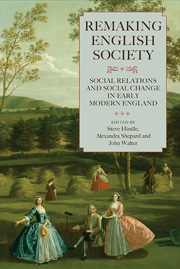Book contents
- Frontmatter
- Contents
- List of Illustrations, Figures, Maps and Tables
- Acknowledgements
- Notes on Contributors
- List of Abbreviations
- 1 The Making and Remaking of Early Modern English Social History
- 2 Brokering Fatherhood: Illegitimacy and Paternal Rights and Responsibilities in Early Modern England
- 3 Gender, Sexuality and the Consumption of Musical Culture in Eighteenth-Century London
- 4 Where was Mrs Turner? Governance and Gender in an Eighteenth-Century Village
- 5 Local Arithmetic: Information Cultures in Early Modern England
- 6 Intoxicants and the Early Modern City
- 7 Food, Drink and Social Distinction in Early Modern England
- 8 Written Obligations, Litigation and Neighbourliness, 1580–1680
- 9 Witchcraft and Neighbourliness in Early Modern England
- 10 Deference, Paternalism and Popular Memory in Early Modern England
- 11 Work, Reward and Labour Discipline in Late Seventeenth-Century England
- 12 Living in Poverty in Eighteenth-Century Terling
- 13 From Commonwealth to Public Opulence: The Redefinition of Wealth and Government in Early Modern Britain
- Appendix: Bibliography of the Published Writings of keith Wrightson from 1974 to 2011
- Index
- Tabula Gratulatoria
- STUDIES IN EARLY MODERN CULTURAL, POLITICAL AND SOCIAL HISTORY
6 - Intoxicants and the Early Modern City
Published online by Cambridge University Press: 05 May 2013
- Frontmatter
- Contents
- List of Illustrations, Figures, Maps and Tables
- Acknowledgements
- Notes on Contributors
- List of Abbreviations
- 1 The Making and Remaking of Early Modern English Social History
- 2 Brokering Fatherhood: Illegitimacy and Paternal Rights and Responsibilities in Early Modern England
- 3 Gender, Sexuality and the Consumption of Musical Culture in Eighteenth-Century London
- 4 Where was Mrs Turner? Governance and Gender in an Eighteenth-Century Village
- 5 Local Arithmetic: Information Cultures in Early Modern England
- 6 Intoxicants and the Early Modern City
- 7 Food, Drink and Social Distinction in Early Modern England
- 8 Written Obligations, Litigation and Neighbourliness, 1580–1680
- 9 Witchcraft and Neighbourliness in Early Modern England
- 10 Deference, Paternalism and Popular Memory in Early Modern England
- 11 Work, Reward and Labour Discipline in Late Seventeenth-Century England
- 12 Living in Poverty in Eighteenth-Century Terling
- 13 From Commonwealth to Public Opulence: The Redefinition of Wealth and Government in Early Modern Britain
- Appendix: Bibliography of the Published Writings of keith Wrightson from 1974 to 2011
- Index
- Tabula Gratulatoria
- STUDIES IN EARLY MODERN CULTURAL, POLITICAL AND SOCIAL HISTORY
Summary
In early 1629 Elizabeth Sanderson sued Alice Wilkinson for defamation in the church courts. Both women ran alehouses in Stonegate, York, with their respective husbands (William Wilkinson and Ralph Sanderson). Elizabeth Sanderson's main witness was her cousin, Anthony Carthorne. He deposed that in August 1628, Alice Wilkinson had sent for him at her alehouse, ostensibly about money he owed her but really to challenge him over her husband's recent arrest ‘at the suit of Ralph Sanderson’. Thomas Prainge, a shoemaker then ‘drinking two pots of ale’, described how Alice Wilkinson told Carthorne ‘you have now gotten your desire, for you have gotten my husband laid in the low gaol’. When Carthorne ‘answered and swore that he did not know of the arrest’, Alice retorted that ‘your drunken wey-necked Jade your cousin [Elizabeth Sanderson] hath caused it to be done, her neighbours take notice of her drunkenness’. It was these menacing words, spoken in anger before witnesses, which gave Elizabeth Sanderson the chance to initiate legal proceedings against Alice Wilkinson.
That Sanderson decided to act on the opportunity is unsurprising. Thanks in large part to Keith Wrightson and other practitioners of the ‘new social history’ it has long been appreciated that one striking – indeed defining – characteristic of early modern England was the increasing willingness of ordinary men and women to appropriate legal institutions to resolve interpersonal conflict. In this respect Ralph and Elizabeth Sanderson were archetypal. Nor is it unexpected that it was an attack on Elizabeth's public reputation which precipitated the suit.
- Type
- Chapter
- Information
- Remaking English SocietySocial Relations and Social Change in Early Modern England, pp. 135 - 164Publisher: Boydell & BrewerPrint publication year: 2013

